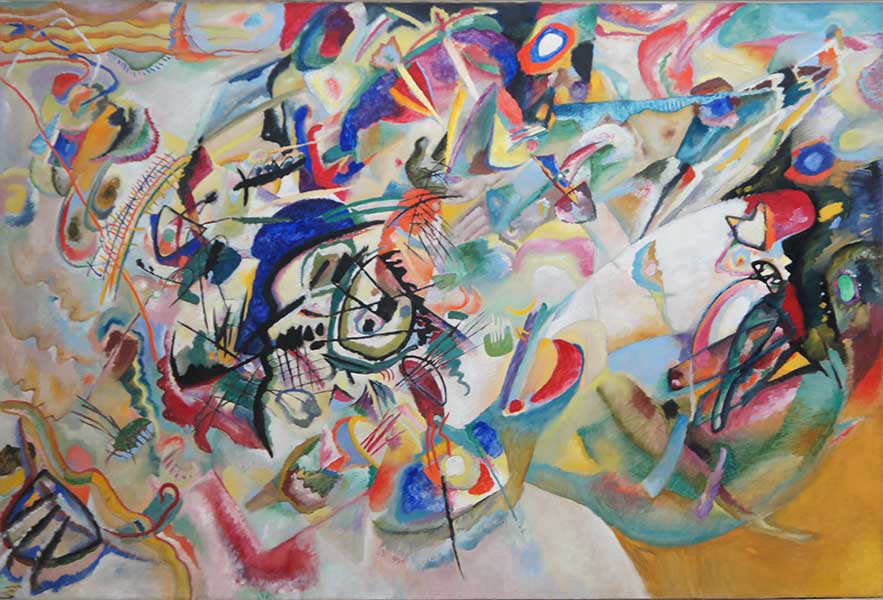Mikhail Vrubel: The Mystic Painter of Russia
by Cathy Locke
Mikhail Vrubel was a Russian painter who is regarded as the greatest Russian Symbolist painter. He did not begin his artistic career until the 1880s and became recognized nationally only in the early 1900s, he died in 1910 at the age of 54. Though he was only loosely associated with the second generation of Russian Symbolist painters called The Blue Rose Group, Vrubel shared common ground with them, especially in his concentration on the supernatural and mystical elements of art.
Vrubel certainly was a pioneer of modernism, not only in his development of style but he was also highly innovative with his technique. He broke with the traditions of the Academy of Arts in St. Petersburg, where he had been a brilliant student. His work conveys a complex an inaccessible inner life, expressing a profoundly spiritual world. In his paintings you will see moments of lucid sensibility that fuse with moments of darkness and distortion. With Vrubel, the mystical aspect takes on increasing significance, so that while appearing to be abstract, his paintings maintain a very strong link with a mystical intuitive world outside the frame.
Mikhail was born in 1856 in Omsk, Siberia. His father was a military lawyer who was very supportive of Mikhail’s love of art as a child. He first went to school to become a lawyer but quickly realized it was not for him, so he entered the Academy of Arts in St. Petersburg. Vrubel later wrote in his 1901 autobiography that his years at the Academy were the best years of his life. Before his& graduation Vrubel was recommended by his teachers to help with the restoration of 20th century icons in the Church of St. Cyril in Kiev. He used this experience to search for greater spirituality and expressiveness through classic art. During the years 1884-1889 he worked in Kiev restoring 150 frescos for St. Cyril’s Church under the supervision of Professor Andrian Prakhov. During this period he began to develop a painting style using fiery and emotional color combinations similar to stained glass. He then went to Venice to learn about the art of Renaissance painters. Next, he was commissioned to paint murals for St. Vladimir’s Cathedral in Kiev. However, he was dismissed from this project because he had an affair with Professor Prakhov’s wife, Emilia. This was the first sign that Vrubel might have some sort of mental illness. At this point in his life, Vrubel distanced himself from Church and started to focus on images of man's inner struggle with his soul. He becomes highly influenced by Lermontov’s poem “The Demon” (1841).
This large painting called “Seated Demon” brought notoriety to Vrubel for the first time. Here Vrubel poses questions of good and evil and putting forward his ideal of a heroic personality as he saw it. Vrubel depicted “a rebel, unwilling to accept the commonplace and unjust nature of reality, tragically alone.” The word “demon” is Greek for “soul” and Vrubel considered a “Demon” in this painting to be the soul of a lonely man. This painting is a very personal reflection for Vrubel as he is exploring his own feelings of loneliness. Vrubel first came up with the idea for this painting in 1889 and he described it as follows:
“A half-naked, winged, young, moody and thoughtful figure sits, hugging his knees against the sunset and looks at a flowering field, where branches rotting under flowers stretch.”
Vrubel places his demon in a horizontal composition which makes the figure feels cramped but increases our impression of his size. This Demon's sadness is not sterile; he is in a world where flowers are transformed into crystals. Working with a palette knife, Vrubel seems to combine the techniques of a painter and a sculptor, which gives rise to monumental technique to imitate mosaics. With this painting “Demon Seated” we see the first significant work of the Russian Symbolist movement. His Demon is full of contradictions: a spiritual face and mighty body. At this point his technique and style are fully evolved. It is characterized by “volume cut into a multitude of interrelated, intersecting facets and planes; broad mosaic brush strokes to model form; fiery and emotional color combinations reminiscent of stained glass. These characteristics appealed not only to the Symbolists but also to future Cubists to come. The theme of Demon, is the epitome of the eternal struggle of an anguished spirit, and became central to the artist's work for the rest of his career.
Even though the critics were not that favorable to Vrubel’s "Seated Demon," he did catch the attention of a very important Muscovite, Savva Mamontov, who was not only wealthy he also had a lot of influence in the art community. Mamontov became Vrubel’s patron and commissioned many works from him. He took Vrubel on a tour of Europe, which included visiting Italy. The paintings “Fortune-Teller”, “Venice” and “Spain” were all painted during this time period. Here we see he was very happy, you could see it in the bright colors that he used. In his painting “Venice” Vrubel starts experimenting with breaking form into cube like shapes. When this painting was first exhibited in Paris, a young Pablo Picasso was very influenced by it and called Vrubel a genius.
In 1896 he fell in love with the opera singer Nadezhda Zabela, whom he married six months later. Because of this relationship he became very interested in art for the theatre and did a number of stage sets, including one for the play “Demon”.
In his 1897 painting “Morning” the subject is a fairytale, the same one that was painted by Ilya Repin. Here a man falls in love with a woman, but needs money in order to marry her. So he goes on a quest to find his riches. On this journey he falls into a body of water, where he meets a water princess who falls in love with him. But he tells her that he is in love with a woman who lives on the land and that he must return to her with his riches. After much time the water princess decides to let him go and as she returns him to the land she bestows on him great wealth. This is a story of true love and sacrifice. Here you see a typical cool color palette of the Russian Symbolist painters – blues, violets, greens, and grays. You see a world that is not one of our reality, but has mystical qualities, a feeling of the unknown. Images come in and out of being fully developed form. Vrubel explores abstraction and pattern. Vrubel also uses the motive of movement, which was a big theme of the Symbolist painters. He uses pattern and value to create a rhythmic movement throughout this painting. Around the head of the water princess we see a halo of gold that also creates a rhythmic pattern. Vrubel used a lot of metallic paint in his work. He often mixed bronze dust with his paint to give his paintings a luminous look. There is some thought among historians that the bronze dust contributed to Vrubel’s mental illness. The symbol of water refers to the unconscious mind, the world of the unknown. Here Vrubel has created a world of the unknown, where maidens pop-up throughout the painting, flowers flow unconnected to any roots, and the viewer just floats from one element to the next.
Falling under the spell of Russian fairytales, Vrubel executed some of his most acclaimed pieces, including “The Bogatyr”, “Pan” “The Swan Czarenvna”, and “Lilacs” between 1898 and 1900. Vrubel was profoundly interested in the supernatural qualities of folklore. Here he could escape to the world of fantasy. This body of work provided a strong stimulus for the younger artists of Moscow to seek inspiration in the mystical and the symbolic.
In 1901, Vrubel returned to the demonic themes in this large canvas called “Demon Downcast”. In order to astound the public with an underlying spiritual message, he repeatedly repainted the demon’s ominous face, even after the painting had been exhibited to the overwhelmed audience. It was said that he worked on this painting even when it was hanging at its exhibition. Often coming into the gallery up to 40 times a day. The painting is one of his last experiments with his most important theme of a free, rebellious, creative spirit, personified in the image of Demon. The hero is thrown down into the chaos of nothingness, into the depth of insensate elements, which is emphasized with wave-like rhythm of the image. The horizontal composition enhances the feeling of a brutal downfall into an abyss of hopeless defeat. The Demon's body, the color of ashes, looks disjointed as if in the grip of torture. His arms twisted crosswise and expanded with wings, and his drawn face with undying light in his eyes remind of another winged creature: Seraph, the spirit of light. Even though the Demon has been vanquished physically, his spirit is undefeatable. He is in the centre of a kind of fiery circle of his own wings. The artist paints peacock feathers using metallic lacquers, making them sparkle and glisten on the dark surface. But it is not only the ornamental beauty of the plumage of the kingly bird that attracts the artist. The peacock is a symbol of imperishability and eternity. The precious feathers wrap around Demon like flames, which brings to memory the legend of the bird Phoenix, which burns, only to rise again from its own ashes.
His last work was a portrait of Valery Bryusov (1906) which was commissioned by Nikolai Ryabushinsky for "The Golden Fleece." Shortly after painting this portrait, Vrubel lost his sight and spent his remaining years deliriously preparing himself for the return of his eyes. Distraught by his blindness and inability to paint, one night in March 1910, Vrubel opened a window and for a period of several hours, exposed his bare chest to the penetrating chill of St. Petersburg. One week later, he succumbed to pneumonia and died. His death was considered a suicide.
Mikhail Vrubel was a painter, sculptor, theater designer, draftsman, and illustrator. His work stands out because of their originality. Despite the absence of direct followers, the importance of Vrubel's art should not be underestimated. He pointed the way and made possible the experiments of the succeeding decades. He influenced Russian Symbolists, the Cubist and abstract movements. He was a transitional figure between traditional and modern art. Vrubel both influenced and inspired artists of a new generation.
About the Author
Cathy Locke is an award-winning fine art painter, professor, published writer and lecturer. She is the editor-in-chief of Musings-on-art.org and specializes in Russian and European art.
Cathy Locke’s artwork – www.cathylocke.com
















